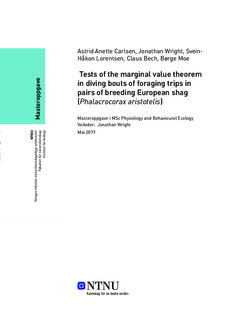| dc.contributor.advisor | Wright, Jonathan | |
| dc.contributor.author | Carlsen,Astrid Anette | |
| dc.contributor.author | Wright, Jonathan | |
| dc.contributor.author | Lorentsen, Svein-Håkon | |
| dc.contributor.author | Bech, Claus | |
| dc.contributor.author | Moe, Børge | |
| dc.date.accessioned | 2019-09-16T14:00:39Z | |
| dc.date.available | 2019-09-16T14:00:39Z | |
| dc.date.issued | 2019 | |
| dc.identifier.uri | http://hdl.handle.net/11250/2617041 | |
| dc.description.abstract | I denne avhandlingen ble tilpasninger av Marginal Value Theorem testet ved bruk av data fra 46.103 dykk av 39 par toppskarv (Phalacrocorax aristotelis) innsamlet over 6 år, med hensyn til fuglers respiratorisk fysiologi og effekten av den individuelle variasjonen i kroppsmasse samt rekkefølgen av sekvensielle dykk. Som predikert, var det tegn på et topppunkt i effektiviteten av dykketid for begge kjønn, og for begge dykketyper (‘jaktdykk’ med horisontalt bevegelsesmønster, kalt bunntid, og "informasjonsdykk» uten åpenbar bunntid). Våre funn tydet på at skarvene planla og tilpasset mengder respiratorisk- og luftsekklagret O2, i tillegg til store mengder blod og vevslagret O2. Toppskarvenes adferd var mer optimal i ‘informasjonssamledykk’, sammenlignet med jaktdykk, beregnet i tidseffektivitet. Dette antyder at de langengre aktive "jaktdykkene" innebar et kompromiss mellom kostnadene ved mindre effektive dykkesykluser med lengre overflatetid versus fordelene med å holde seg under vann i lang tid for å fange unnvikende byttedyr. Disse resultatene antyder at den mer raffinerte MVT-modellen, med hensyn til ulike typer aviær O2-lagring (luftsekker versus blod- og vevslager) og deres ulike opptaksrater, er en mer nøyaktig måte å bestemme tidseffektiviteten til toppskarven i dykk for matsøk. Imidlertid ble det ikke funnet viktige effekter av individuell kroppsmasse på MVT-prediksjonene, og interaksjoner med følgeeffekten av flere dykk på rad tyder på at opprettholding av kroppstemperatur også kan være et problem i dette systemet. Ytterligere statistiske analyser anbefales, som kan brukes til å undersøke disse effektene i lys av optimalitetsprediksjoner og kunnskap om fuglefysiologi. | |
| dc.description.abstract | In this thesis adaptations of the optimal foraging model the Marginal Value Theorem (MVT)
were tested using data from 46,103 foraging dives of 39 pairs of European shags (Phalacrocorax
aristotelis) collected over 6 years, taking into account avian respiratory physiology and the
effects of individual variation in body mass and the order of sequential dives. As predicted, there
was evidence for a peak in the efficiency of dive durations for both sexes and for both types of
dive (‘hunting’ dives with a flat bottom depth and ‘sampling’ dives without any obvious bottom
duration). There were also suggestions that the birds anticipated and adjusted to the different
metabolic demands of longer dives using not only air-sac O2 but also substantial amounts of
blood O2. The shags behaved closer to the predicted optimum dive durations, calculated in terms
of time efficiency, during the presumed information gathering ‘sampling’ dives with no bottom
time. This suggests that the overly-long active ‘hunting’ dives involved a trade-off between the
costs of less efficient dive cycles with extended surface durations versus the benefits of staying
down sufficiently long to catch elusive fish prey. These results suggest that the more refined
MVT model, which takes in to account the different types of avian O2 storage (air sac versus
blood) and their contrasting uptake rates, is a more accurate way of determining the time
efficiency of shag foraging dives. However, important effects of individual body mass on MVT
predictions were not found and clear interaction effects with dive order suggest that maintaining
body temperature might also be an issue in this system. Further statistical analyses are
recommended that could be used to investigate these effects in light of optimality predictions and
knowledge of avian physiology. | |
| dc.language | eng | |
| dc.publisher | NTNU | |
| dc.title | Tests of the Marginal Value Theorem in diving bouts of foraging trips in pairs of breeding European shag (Phalacrocorax aristotelis) | |
| dc.type | Master thesis | |
